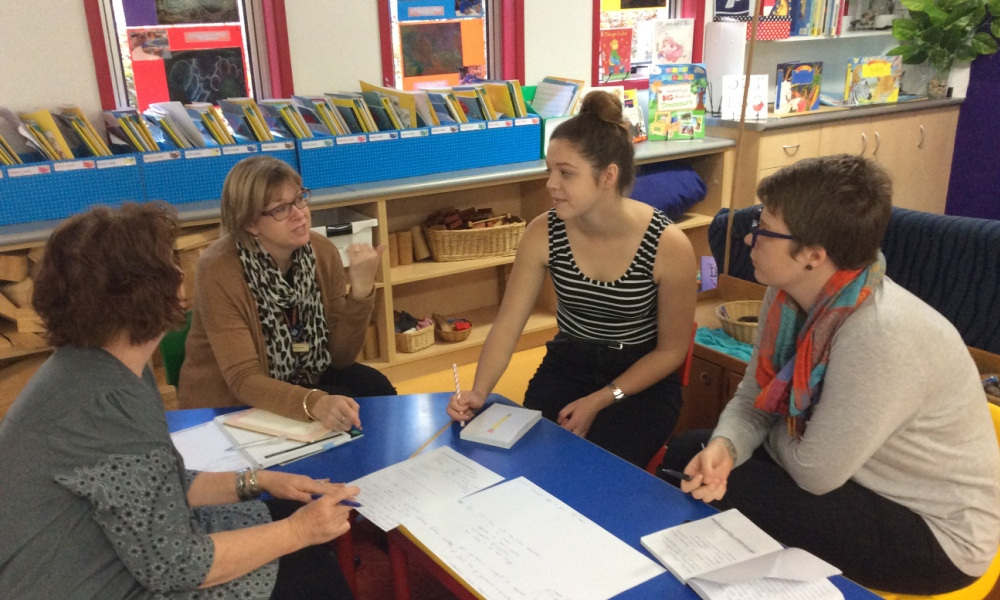In a recent episode of The Research Files, we brought you news of an Australian study exploring the highs and lows of the practicum experience for pre-service teachers. One of the themes to emerge from the research was the importance of good mentoring. Here, two supervising teachers and two pre-service teachers who worked together in Semester One 2017 reflect on some of the elements that helped to drive a positive practicum experience for everyone involved.
The Action Now: Classroom Ready Teachers report of 2014 made recommendations on how to better prepare graduate teachers in Australia with the practical skills required for classroom work. It concluded that the single most significant action would involve close partnerships between universities, school systems and schools in an attempt to provide a more integrated delivery of initial teacher education (Teacher Education Ministerial Advisory Group, 2014).
A key element involves mentoring and support for pre-service teachers to learn to continually reflect on their own practice. The report recommended that supervising teachers should have the training and skills required to effectively supervise and assess professional experience placements. In addition, it found that beginning teachers require guidance to develop the ability to effectively communicate with students and their families, particularly with regard to a child's academic progress. These are all key roles supported by the supervising teacher.
Many pre-service teachers have indicated that the practicum experience in schools had the greatest impact on learning to teach (Adoniou, 2013; Hastings, 2010). Of critical importance in this learning process is the rapport between the supervising teacher and the pre-service teacher. By its very nature this relationship will vary greatly according to personalities and experiences. As the coach, mentor, guide and assessor, the supervising teacher is in a position to model excellent practice around the development of professional relationships that advantage all parties.
At St Peters Lutheran College in Brisbane, Preparatory teacher Deb Wilson worked with Hannah Davis from Australian Catholic University and Preparatory teacher Adele Amorsen worked with Catherine Ayres from Queensland University of Technology during Semester One 2017.
The supervising teachers developed their skills as coach, mentor and assessor using a set of four self-paced modules available through the Australian Institute for Teaching and School Leadership (AITSL) website. The modules involve the development of effective partnerships, practice analysis, making judgements and unpacking the graduate standards. Here, we share our thoughts on some of the issues that helped to drive a positive experience for everyone involved.
What can supervising teachers do?
To be an effective supervising teacher requires an open-minded, positive attitude combined with an understanding of the external factors impacting on pre-service teachers (e.g. assignments, part-time jobs, family). Developing an understanding of the way each person operates and sharing some personal information can help to establish a productive working relationship.
Sometimes, entering a school can be overwhelming and a pre-service teacher may fear they won't live up to expectations. Taking the time to unpack expectations and allowing an appropriate amount of time for the pre-service teacher to find their feet is important. Consider the following when assisting a pre-service teacher to have a positive, effective experience:
- An understanding of the commitment that's required on both sides;
- Prepare an introductory email to introduce the pre-service teacher to families, the school community and other teachers as a positive growth tool for everyone;
- Model a positive, respectful relationship between the pre-service teacher and supervising teacher and this will encourage families to engage and develop a team approach;
- Pre-service teachers can learn how to be part of great team by experiencing and seeing this team approach from a range of school staff willing to support them, as well as tapping into university staff, school families and community involvement;
- Encourage the asking of questions and provide the opportunity to do this regularly; and
- Enjoy the opportunity to learn from each other.
What can pre-service teachers do?
Pre-service teacher's attitudes, beliefs and approaches towards their practical experience greatly influences what is learnt from their experiences and their vision of teaching (Naylor, Campbell-Evans, & Maloney, 2015). Pre-service teachers are most likely to flourish if they embrace the experience with a positive attitude and an open mind, and are prepared to accept a proactive role in their learning. Here are some practical ways in which they can do this.
- Actively build a respectful and open relationship with their supervising teacher by sharing thoughts and listening. This could include past experiences and professional strengths and weaknesses;
- Form relationships with students, parents and other staff to build trust, create networks and be a part of the school community;
- Engage in self-reflection regularly. Analyse teaching practices and seek to continuously improve;
- Communicate any concerns with the supervising teacher and ask questions at every opportunity;
- Demonstrate a willingness to learn from all experiences by listening to and acting on feedback; and
- Be open to reflect on and engage with new ideas and consider alternative perspectives presented.
Feedback and communication
Open channels of communication, and regular feedback are the foundation of a successful professional experience. For the supervising teacher, positive relationships can be established at the beginning of the practicum by setting clear expectations with the pre-service teacher: what you expect from them, and what they can expect from you. Encouragement to ask questions, daily reflection on practice and seeking help or advice when needed will all support quality conversations.
In our experience, providing valuable feedback allows pre-service teachers to improve their practice, and encourages supervising teachers to reflect on their own. What does quality feedback look like?
- Detailed, but not overwhelming. Emphasise one or two points that can be incorporated as focus areas for the next day;
- Make it mutual. Encourage self-reflection after lessons, and model this for the pre-service teachers;
- Feedback covers not just lessons, but the entire scope of teaching practice. Consider transitions, behaviour management, resources and teacher presence – how they are used effectively, or how they could be improved; and
- Feedback should be both verbal and written, scheduled and spontaneous. Provide a range of different styles of feedback to find what suits your setting. This may be daily emails, written feedback on lesson plans, a quick debrief after a lesson or a scheduled meeting each afternoon.
Difficult conversations
While some pre-service teachers cope well with their professional experience, some can be overwhelmed with multiple responsibilities and the management of the complex roles and expectations. In these situations the supervising teacher is often the one who needs to begin some difficult communication. We found that starting the conversations early, being aware of university policy and procedures and approaching with a growth mindset all helped. Here are our tips:
- Keep conversations highly professional, avoiding personal comments or judgement;
- Use a collaborative approach, seeking input and support from other teachers, school administration and university based teacher educators;
- Consider the vocabulary used. Growth mindset language can be used to guide and motivate for improvement;
- Give evidence-based feedback in a timely manner, as soon as possible after a lesson;
- Allow your pre-service teacher to self-reflect on a lesson and listen carefully. Then provide feedback on their reflection and give support advice/ideas for improvement;
- Be specific about the particular skills that are yet to develop and give very detailed advice, support and modelling. Tackle one issue at a time if necessary and build it in to each new successive lesson plan;
- Consider using the processes from the Gradual Release of Responsibility Model to further support pre-service teachers who need extra guidance.
References
Adoniou, M. (2013). Preparing teachers – The importance of connecting contexts in teacher education. Australian Journal of Teacher Education, 38 (8), 47-60.
Hastings, P. (2010). Expectation of a pre-service teacher: Implications of encountering the unexpected. Asia-Pacific Journal of Teacher Education, 38 (3), 207-219.
Naylor, D. A., Campbell-Evans, G., & Maloney, C. (2015). Learning to Teach: What Do Pre-service Teachers Report. Australian Journal of Teacher Education, 40 (11).
Teacher Education Ministerial Advisory Group (2014). Action Now: Classroom Ready Teachers. Retrieved from https://docs.education.gov.au/documents/action-now-classroom-ready-teachers-report
The supervising teachers found that setting clear expectations early helped to build a positive relationship. As a mentor, do you discuss what will be expected from both parties?
When a pre-service teacher or new member of staff joins your school how do you help to create a welcoming environment?
In the case of a pre-service teacher joining your class, do you take the time to introduce them to students’ families, the wider school community and colleagues?



